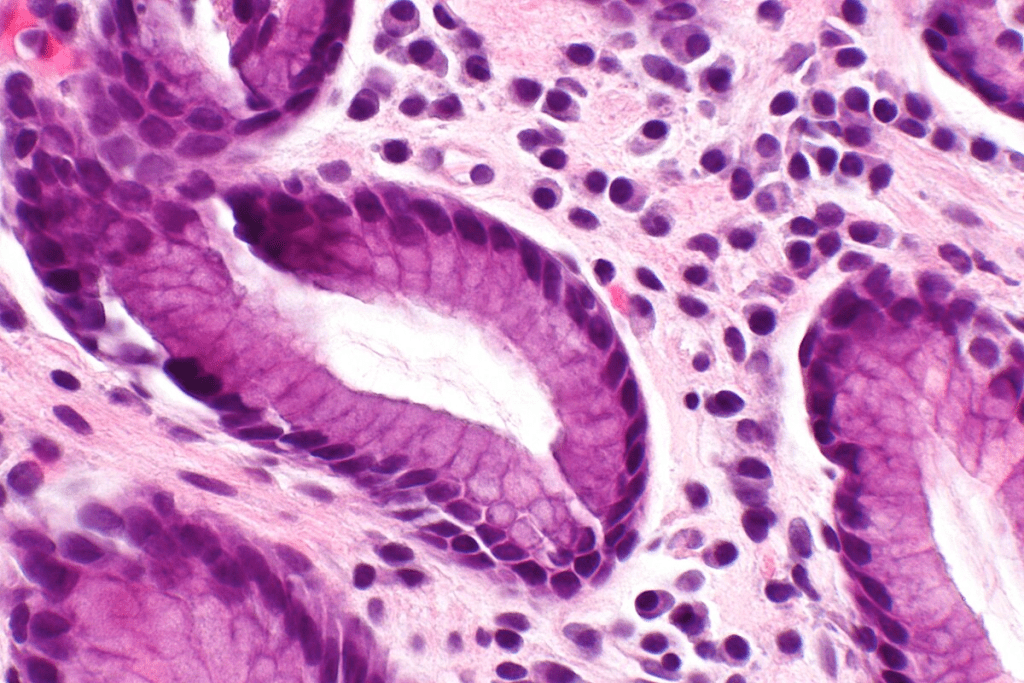Last Updated on November 14, 2025 by
Hirschsprung’s disease is a birth defect that affects about 1 in 5,000 babies. It happens when certain nerve cells are missing in parts of the bowel. This leads to very bad constipation and blockages in the intestines, making life hard for kids with it.

Studies have found a strong link between Hirschsprung’s disease and Down syndrome. A study on PubMed shows that kids with Down syndrome are more likely to have hirschsprung down syndromedown syndrome disease. This shows we need to take care of these kids in a special way.
We will look into the numbers, risks, and new ways to help kids with Hirschsprung’s disease and Down syndrome. We’ll learn more about the challenges they face and how we can help.
Hirschsprung’s disease is a condition where certain parts of the colon lack ganglion cells. This happens because of a problem during fetal development. Neural crest cells fail to reach the distal bowel.
The lack of ganglion cells in the colon’s lower parts causes a blockage. This is because the affected area can’t relax and move the stool. As a result, the colon gets clogged, leading to severe constipation or blockage soon after birth.

Hirschsprung’s disease is rare, affecting about 1 in 5,000 babies. Its occurrence can vary among different groups, with some studies showing higher rates in certain ethnicities.
Thanks to better surgery and care, death rates from Hirschsprung’s disease have dropped. Yet, death rates can be as high as 20-25% in complex cases. Those with Down syndrome face even higher risks, with a mortality rate of 7.32%.
Important statistics include:
Healthcare providers must understand Hirschsprung’s disease well. This is vital, as those with Down syndrome are at a higher risk of complications.
Down syndrome is a genetic condition caused by an extra chromosome 21. It affects many areas of health. It’s the most common chromosomal abnormality linked to Hirschsprung’s disease.

Down syndrome happens when there’s an extra copy of chromosome 21. This extra genetic material changes how a person develops. It leads to the traits seen in Down syndrome.
The extra chromosome impacts many body systems. It also raises the risk of several health problems.
Trisomy 21 is the main cause, found in about 95% of cases. Mosaicism or translocation can also cause it, but these are rarer.
Down syndrome affects about 1 in 600-700 babies born. It’s a common condition, and knowing about it is key to managing related health issues.
The risk of having a child with Down syndrome goes up with the mother’s age, after 35. Yet, most children with Down syndrome are born to younger mothers.
People with Down syndrome face many health challenges. These include heart defects, a higher risk of infections, and gastrointestinal issues like Hirschsprung’s disease.
There’s a strong link between Down syndrome and Hirschsprung’s disease. Many children with Hirschsprung’s also have Down syndrome. Knowing about these health challenges helps in providing better care.
Healthcare providers can offer better support and care by understanding these challenges. This improves the lives of those with Down syndrome.
Hirschsprung’s disease and Down syndrome are linked, with strong evidence showing their connection. Children with Down syndrome face a higher risk of getting Hirschsprung’s disease than others.
Prevalence in Down Syndrome: Research shows that 1-2% of children with Down syndrome get Hirschsprung’s disease. This is a big risk, as Hirschsprung’s is rare in the general population.
Children with Down syndrome are much more likely to get Hirschsprung’s disease. About 1-2% of them will develop it, which is a lot higher than in the general population.
On the other hand, a large number of Hirschsprung’s patients also have Down syndrome. Studies say 3-10% of those with Hirschsprung’s also have Down syndrome. This shows a strong connection between the two conditions.
The reasons for the high risk of Hirschsprung’s in Down syndrome are complex. Children with Down syndrome are 50- to 100-fold more likely to get Hirschsprung’s than others. This is because Down syndrome’s genetic issues affect the enteric nervous system’s development.
Our study confirms a strong link between Hirschsprung’s disease and Down syndrome. Knowing this helps in early diagnosis and treatment of Hirschsprung’s disease in children with Down syndrome.
Hirschsprung’s disease and Down Syndrome have a complex relationship. Hirschsprung’s disease is caused by missing nerve cells in the bowel. This leads to severe constipation or blockage if not treated quickly.
Newborns with Hirschsprung’s disease show signs early on. These early warning signs include not passing meconium in the first 48 hours, a swollen belly, and vomiting that brings up bile. Children with Down Syndrome might show these signs more or with other problems.
Healthcare providers must spot these signs and start testing to confirm the diagnosis. Waiting too long can cause serious problems, like enterocolitis, which makes things worse.
Diagnosing Hirschsprung’s disease involves several steps. First, a contrast enema is done. It shows a clear line where the bowel changes size.
The next step is a rectal biopsy. It’s the best way to confirm the disease. The biopsy checks for missing nerve cells in the bowel.
Early diagnosis is key for treating Hirschsprung’s disease, even more so in children with Down Syndrome. Knowing the signs and using the right tests helps doctors act fast. This can greatly improve a child’s health.
Patients with Hirschsprung’s disease, including those with Down syndrome, face unique challenges. Surgery is the main treatment to remove the affected part. This aims to restore normal bowel function.
Before surgery, it’s key to stabilize the patient. This includes managing complications like enterocolitis. Preoperative care involves bowel decompression, antibiotics, and nutritional support.
Modern surgery offers several treatments for Hirschsprung’s disease. The Swenson, Duhamel, and Soave procedures are common. Each has its benefits and risks. The right surgery depends on the patient’s health and the surgeon’s skill.
Postoperative care is vital to avoid complications and aid recovery. Patients with Hirschsprung’s disease and Down syndrome are at higher risk. Close monitoring and follow-up care are key to managing these risks.
Managing Hirschsprung’s disease in patients with Down syndrome needs a detailed approach. Healthcare providers must understand treatment options and complications. This way, they can offer the best care for these patients.
Hirschsprung’s disease and Down syndrome together need a team effort. Up to 30% of Hirschsprung’s patients have other birth defects. This shows why a team approach is key.
Managing Hirschsprung’s disease in Down syndrome patients requires a team. This team includes pediatric surgeons, geneticists, and cardiologists. We work together to cover all health aspects.
“A team effort is vital for complex care,” says the importance of teamwork in healthcare.
Up to 30% of Hirschsprung’s patients have more birth defects. We focus on early detection and management. This may include various tests and treatments.
This approach helps avoid complications and improves health outcomes.
Long-term care is essential for Hirschsprung’s disease and Down syndrome patients. We provide ongoing monitoring and support. This includes regular check-ups and adjusting treatment plans as needed.
We also offer support for families dealing with these conditions. This includes counselling, educational materials, and support group connections. Empowering families helps them care for their loved ones better.
Liv Hospital shows the best way to manage complex conditions. By following their example, we can give patients the care they need.
It’s important to understand how Hirschsprung’s disease and Down syndrome are connected. Our research found that when these conditions happen together, it can lead to more problems. This includes higher rates of infections, worse outcomes after surgery, and even higher death rates.
For patients facing these challenges, getting the right care is vital. A team of specialists working together is key. They can tackle the complex issues that come with both conditions.
Healthcare teams need to recognize the deep link between these diseases. This way, they can create plans that meet the unique needs of these patients. This approach can greatly improve their quality and how well they respond to treatment.
Hirschsprung’s disease is a birth defect where the bowel lacks nerve cells. This causes a blockage in the intestines. Children with Down syndrome are more likely to have this condition.
Look out for signs like not passing meconium in the first 48 hours, swollen belly, vomiting, and constipation. These could mean Hirschsprung’s disease and need a doctor’s check.
Doctors use a few methods to diagnose it. They look at symptoms, do X-rays and contrast enemas, and take a biopsy to check for nerve cells.
Treatment is surgery to remove the blocked part of the bowel. Kids with Down syndrome might need extra care because of other health issues.
A team of doctors is key for complex cases. They manage other health issues, provide ongoing care, and support families. This ensures the best care for kids.
About 1-2% of kids with Down syndrome get Hirschsprung’s disease. This makes it important to watch for signs early.
Complications include infections, blockages, and surgery problems. Quick treatment and ongoing care help manage these issues.
Families can find help through advocacy groups, counselling, and online forums. These resources offer support and guidance through tough times.
Subscribe to our e-newsletter to stay informed about the latest innovations in the world of health and exclusive offers!